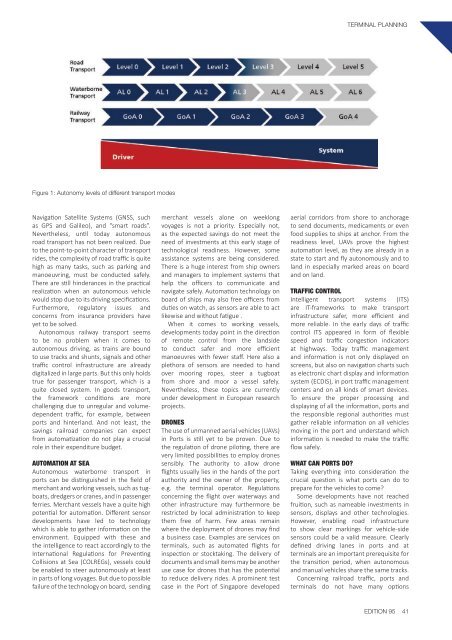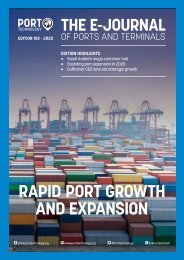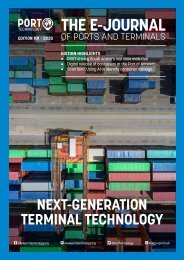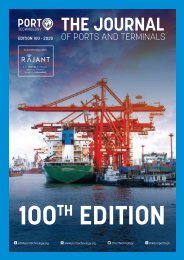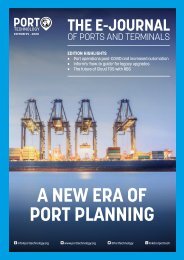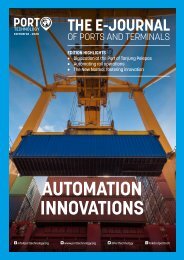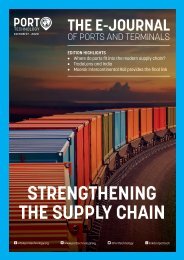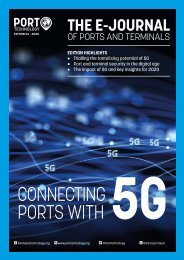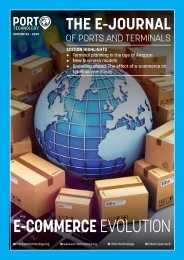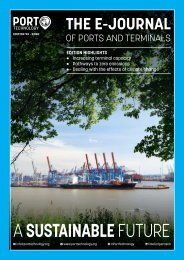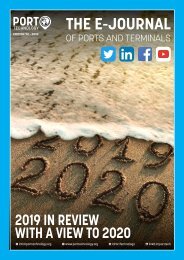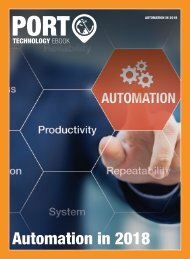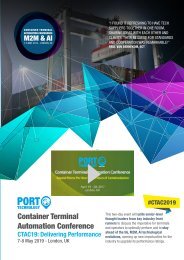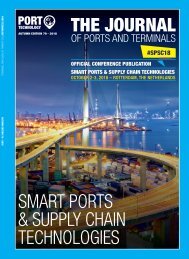Automation's Next Step
This edition of The Journal considers automation of container terminals and how the industry is delivering the next steps towards full and semi-automation. With the inclusion of over 30 technical papers The Journal also explores terminal planning in the age of automation, environmental sustainability for ports, the impact of mega ships and other topics. Automation continues to drive innovation across several industries, and there is no greater example of this than maritime. However, implementation, technology and best practices continue to be a constant source of debate and analysis across the sector, as is shown in this edition of the PTI Journal. The automation debate is not new, but it remains a booming market and a source of growth for the wider container terminal industry. One thing is for certain, automation is here to stay.
This edition of The Journal considers automation of container terminals and how the industry is delivering the next steps towards full and semi-automation.
With the inclusion of over 30 technical papers The Journal also explores terminal planning in the age of automation, environmental sustainability for ports, the impact of mega ships and other topics.
Automation continues to drive innovation across several industries, and there is no greater example of this than maritime.
However, implementation, technology and best practices continue to be a constant source of debate and analysis across the sector, as is shown in this edition of the PTI Journal.
The automation debate is not new, but it remains a booming market and a source of growth for the wider container terminal industry.
One thing is for certain, automation is here to stay.
You also want an ePaper? Increase the reach of your titles
YUMPU automatically turns print PDFs into web optimized ePapers that Google loves.
TERMINAL PLANNING<br />
Figure 1: Autonomy levels of different transport modes<br />
Navigation Satellite Systems (GNSS, such<br />
as GPS and Galileo), and “smart roads”.<br />
Nevertheless, until today autonomous<br />
road transport has not been realized. Due<br />
to the point-to-point character of transport<br />
rides, the complexity of road traffic is quite<br />
high as many tasks, such as parking and<br />
manoeuvring, must be conducted safely.<br />
There are still hinderances in the practical<br />
realization when an autonomous vehicle<br />
would stop due to its driving specifications.<br />
Furthermore, regulatory issues and<br />
concerns from insurance providers have<br />
yet to be solved.<br />
Autonomous railway transport seems<br />
to be no problem when it comes to<br />
autonomous driving, as trains are bound<br />
to use tracks and shunts, signals and other<br />
traffic control infrastructure are already<br />
digitalized in large parts. But this only holds<br />
true for passenger transport, which is a<br />
quite closed system. In goods transport,<br />
the framework conditions are more<br />
challenging due to unregular and volumedependent<br />
traffic, for example, between<br />
ports and hinterland. And not least, the<br />
savings railroad companies can expect<br />
from automatization do not play a crucial<br />
role in their expenditure budget.<br />
AUTOMATION AT SEA<br />
Autonomous waterborne transport in<br />
ports can be distinguished in the field of<br />
merchant and working vessels, such as tugboats,<br />
dredgers or cranes, and in passenger<br />
ferries. Merchant vessels have a quite high<br />
potential for automation. Different sensor<br />
developments have led to technology<br />
which is able to gather information on the<br />
environment. Equipped with these and<br />
the intelligence to react accordingly to the<br />
International Regulations for Preventing<br />
Collisions at Sea (COLREGs), vessels could<br />
be enabled to steer autonomously at least<br />
in parts of long voyages. But due to possible<br />
failure of the technology on board, sending<br />
merchant vessels alone on weeklong<br />
voyages is not a priority. Especially not,<br />
as the expected savings do not meet the<br />
need of investments at this early stage of<br />
technological readiness. However, some<br />
assistance systems are being considered.<br />
There is a huge interest from ship owners<br />
and managers to implement systems that<br />
help the officers to communicate and<br />
navigate safely. Automation technology on<br />
board of ships may also free officers from<br />
duties on watch, as sensors are able to act<br />
likewise and without fatigue .<br />
When it comes to working vessels,<br />
developments today point in the direction<br />
of remote control from the landside<br />
to conduct safer and more efficient<br />
manoeuvres with fewer staff. Here also a<br />
plethora of sensors are needed to hand<br />
over mooring ropes, steer a tugboat<br />
from shore and moor a vessel safely.<br />
Nevertheless, these topics are currently<br />
under development in European research<br />
projects.<br />
DRONES<br />
The use of unmanned aerial vehicles (UAVs)<br />
in Ports is still yet to be proven. Due to<br />
the regulation of drone piloting, there are<br />
very limited possibilities to employ drones<br />
sensibly. The authority to allow drone<br />
flights usually lies in the hands of the port<br />
authority and the owner of the property,<br />
e.g. the terminal operator. Regulations<br />
concerning the flight over waterways and<br />
other infrastructure may furthermore be<br />
restricted by local administration to keep<br />
them free of harm. Few areas remain<br />
where the deployment of drones may find<br />
a business case. Examples are services on<br />
terminals, such as automated flights for<br />
inspection or stocktaking. The delivery of<br />
documents and small items may be another<br />
use case for drones that has the potential<br />
to reduce delivery rides. A prominent test<br />
case in the Port of Singapore developed<br />
aerial corridors from shore to anchorage<br />
to send documents, medicaments or even<br />
food supplies to ships at anchor. From the<br />
readiness level, UAVs prove the highest<br />
automation level, as they are already in a<br />
state to start and fly autonomously and to<br />
land in especially marked areas on board<br />
and on land.<br />
TRAFFIC CONTROL<br />
Intelligent transport systems (ITS)<br />
are IT-frameworks to make transport<br />
infrastructure safer, more efficient and<br />
more reliable. In the early days of traffic<br />
control ITS appeared in form of flexible<br />
speed and traffic congestion indicators<br />
at highways. Today traffic management<br />
and information is not only displayed on<br />
screens, but also on navigation charts such<br />
as electronic chart display and information<br />
system (ECDIS), in port traffic management<br />
centers and on all kinds of smart devices.<br />
To ensure the proper processing and<br />
displaying of all the information, ports and<br />
the responsible regional authorities must<br />
gather reliable information on all vehicles<br />
moving in the port and understand which<br />
information is needed to make the traffic<br />
flow safely.<br />
WHAT CAN PORTS DO?<br />
Taking everything into consideration the<br />
crucial question is what ports can do to<br />
prepare for the vehicles to come?<br />
Some developments have not reached<br />
fruition, such as nameable investments in<br />
sensors, displays and other technologies.<br />
However, enabling road infrastructure<br />
to show clear markings for vehicle-side<br />
sensors could be a valid measure. Clearly<br />
defined driving lanes in ports and at<br />
terminals are an important prerequisite for<br />
the transition period, when autonomous<br />
and manual vehicles share the same tracks.<br />
Concerning railroad traffic, ports and<br />
terminals do not have many options<br />
EDITION 95 41


